

|
| ČESKÁ REPUBLIKA | CZECH REPUBLIC |
| Hlavní město PRAHA | Prague |
Prague is the capital and largest city of the Czech Republic. Situated on the Vltava river in central Bohemia, it is home to approximately 1.2 million people. Nicknames for Prague have included "city of a hundred spires" or "the golden city". Since 1992, the historic center of Prague (together with the Průhonice park) has been included in the UNESCO list of World Heritage sites (see also list of other UNESCO heritage sites).
The area on which Prague was founded has been settled since the Paleolithic Age. According to legend, Prague was founded by the Princess Libuše and her husband, Přemysl, founder of the dynasty with the same name. Whether this legend is true or not, Prague's first nucleus was founded in the latter part of the 9th century as a castle on a hill commanding the right bank of the Vltava: this is known as Vyšehrad ("high castle") to differentiate from the castle which was later erected on the opposite bank, the future Hradčany. Soon the city became the seat of the Kings of Bohemia. In 1257, under King Otakar II, Malá Strana ("Lesser Side") was founded in Prague in the future Hradčany area as the district of the Germans, who had the right to administer the law autonomously, referring to the Magdeburg legislation. The new district was on the opposite bank to the Staré Město ("Old Town"), which had then borough status and was defended by a line of walls on fortifications. The city flourished during the 14th century reign of Charles IV, of the new Luxembourg dynasty. He ordered the building of the New Town (Nové Město) adjacent to the Old Town. The Charles Bridge was erected to connect the new district to Malá Strana. In the following two centuries Prague strengthened its role as a merchant city. In 1526 the Kingdom of Bohemia came in possession of the House of Habsburg. The fervent Catholicism of its members was to have grevious consequences in Bohemia, and then in Prague, where Protestant ideas instead had increasing popularity. These problems were not preeminent under Emperor Rudolf II, elected King of Bohemia in 1576, who chose Prague as his home. In 1618 the famous Defenestration of Prague provoked the Thirty Years' War (1618–1648). Ferdinand II moved the court to Vienna, and Prague began a steady decline. In 1689 a great fire devastated Prague, but this spurred a renovation and a rebuilding of the city. In 1784, under Joseph II, the four municipalities of Hradčany, Malá Strana, Nové Město and Staré Město were merged into a single entity. The Jewish district, Josefov, was included only in 1850.
World War I ended with the defeat of Austria-Hungary and the creation of Czechoslovakia. Prague was chosen as its capital. For most of its history Prague had been a multiethnic city with important Czech, German, and (mostly Yiddish- and/or German-speaking) Jewish populations. From 1939, when the country was occupied by Nazi Germany, and during World War II, most Jews either were forced to flee the city or were killed in the Holocaust. The German population, which had formed the majority of the city's inhabitants until the 19th century, was expelled or fled in the aftermath of the war. Prague was thenceforth the capital of a Communist Republic under the military and political control of Soviet Union, and in 1955 it entered the Warsaw Pact. It was the Prague Spring, which aimed at democratic reform of institutions. The Soviet Union and the rest of the Warsaw Pact reacted, occupying Czechoslovakia and the capital in August 1968. In 1989, after the Berlin Wall had fallen, and the Velvet Revolution crowded the streets of Prague, Czechoslovakia finally freed itself from communism and Soviet influence. In 1993, after the split of Czechoslovakia, Prague became capital city of the new Czech Republic. Together with Avignon, Bergen, Bologna, Brussels, Helsinki, Kraków, Reykjavik and Santiago de Compostela, Prague was selected as European Capital of Culture for the year 2000.
Hradčany (German: Hradschin) is the district of the city of Prague surrounding Prague Castle. Hradčany was an
independent borough until 1784, when the four independent boroughs that had formerly constituted Prague were proclaimed a single city. The other three
were Malá Strana (German: Kleinseite, i.e. 'Lesser Side'), Staré Město (German: Altstadt, 'Old Town') and
Nové Město (German: Neustadt, 'New Town').
The
[https://en.wikipedia.org/wiki/Hrad%C4%8Dany;
https://en.wikipedia.org/wiki/Prague_Castle;
https://en.wikipedia.org/wiki/St._Vitus_Cathedral]
The
The
The glass stein is labeled on the side V UPOMÍNKU KOLEGOVI PŘEDSEDOVI KROUŽEK „NÁLADA“.
Glass no. 3757 [near left] is labeled Pozdrav z Československé Prahy
The Battle of Vyšehrad was a series of engagements at the start of the Hussite War between Hussite forces and Catholic
crusaders sent by Emperor Sigismund. The battle took place at the castle of Vyšehrad from 16 August 1419
to 1 November1420.
Vyšehrad cemetery behind the church was established in 1869. It is the final resting place of many
famous Czechs, including the playwright Karel Čapek (1890–1938),
the composers Bedřich Smetana (1824–1884) and Antonín Dvořák (1841–1904),
the poets Karel Hynek Mácha (1810–1836) and Jan Nepomuk Neruda (1834–1891),
the painter Alfons Mucha (1860–1939),
and the conductor Rafael Kubelik (1914–1996).
(see also list of other basilicae minores depicted on glasses of this collection)
[https://de.wikipedia.org/wiki/Basilika_St._Peter_und_Paul_(Prag);
https://de.wikipedia.org/wiki/Vy%C5%A1ehrad]
The building shown in the right background was the
[http://en.wikipedia.org/wiki/Prague,
http://en.wikipedia.org/wiki/Charles_Bridge,
http://en.wikipedia.org/wiki/Wenceslas_Square,
http://en.wikipedia.org/wiki/National_Museum_(Prague),
http://www.nm.cz/English/index.php,
http://en.wikipedia.org/wiki/National_Theatre_(Prague),
http://www.prague-info.cz/en/prague/monuments/st_nicholas_church_lesser_town,
http://pubweb.northwestern.edu/~aro918/dictionary.htm,
http://www.to-prague.com/prague_city_guide/monuments,
http://en.wikipedia.org/wiki/Žižkov,
http://en.wikipedia.org/wiki/Vyšehrad,
http://en.wikipedia.org/wiki/Vyšehrad_cemetery,
http://en.wikipedia.org/wiki/Czechoslovak_Hussite_Church;
http://www.sberatel-ksk.cz/clanek-prazska-jubilejni-vystava-1908-2008050004;
https://en.wikipedia.org/wiki/Mánes_Bridge;
https://is.cuni.cz/webapps/zzp/download/120304731&usg=AOvVaw1t96KvG_sH-ZgWpEByE0CD,
https://cs.wikipedia.org/wiki/Richard_Klenka;
https://de.wikipedia.org/wiki/Prager_Jubil%C3%A4umsausstellung_1891;
https://cs.wikipedia.org/wiki/V%C5%A1esokolsk%C3%BD_slet, https://en.wikipedia.org/wiki/Sokol;
https://de.wikipedia.org/wiki/Kreuzherrenkirche_(Prag);
https://en.wikipedia.org/wiki/St._Salvator_Church]
Hradčany
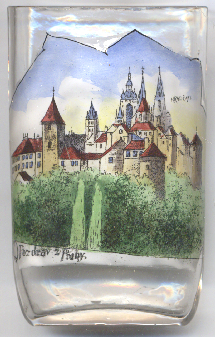
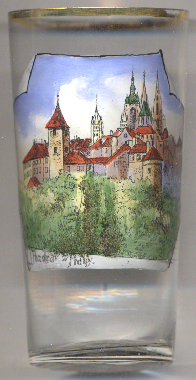
 Prague Castle was originally built in the 9th century and has long served as the seat of power for
kings of Bohemia, Holy Roman emperors, and today as the official residence and workplace of the president of the Czech Republic. The castle
is deemed the largest ancient castle in the world, occupying an area of almost 70,000 square metres, at about 570 metres in length and
an average about 130 metres wide. The castle is among the most visited tourist attractions in Prague, attracting over 1.8 million
visitors annually.
Prague Castle was originally built in the 9th century and has long served as the seat of power for
kings of Bohemia, Holy Roman emperors, and today as the official residence and workplace of the president of the Czech Republic. The castle
is deemed the largest ancient castle in the world, occupying an area of almost 70,000 square metres, at about 570 metres in length and
an average about 130 metres wide. The castle is among the most visited tourist attractions in Prague, attracting over 1.8 million
visitors annually.
 Metropolitan Cathedral of Saints Vitus, Wenceslaus and Adalbert [background right] is the seat of the archbishop of Prague.
Until 1997, the cathedral was dedicated only to Saint Vitus, and is still commonly named only as 'St. Vitus Cathedral'. This cathedral
is a prominent example of Gothic architecture, and is the largest and most important church in the country. Located within Prague Castle and
containing the tombs of many Bohemian kings and Holy Roman Emperors, the cathedral is under the ownership of the Czech government as part of
the Prague Castle complex. The current cathedral is the third of a series of religious buildings at the site, all dedicated to St. Vitus.
The first church was an early Romanesque rotunda founded in 930. In 1060, when the bishopric of Prague was founded, a second, more spacious
Romanesque basilica was started. The southern apse of the rotunda was incorporated into the eastern transept of the new church because it housed
the tomb of St. Wenceslaus, who had by now become the patron saint of the Czech princes. Construction of the present-day Gothic cathedral
began in 1344, when the seat of Prague was elevated to an archbishopric. The main architect of the Gothic church was Peter Parler. However,
work proceeded only slowly, so that by 1397, when parler died, only the choir and parts of the transept were finished. Thereafter, Peter's sons,
Wenzel and Johannes, continued his work. The entire building process came to a halt with the beginning of Hussite War in the first half of
15th century. Through most of the following centuries, the cathedral stood only half-finished. It was built to the great tower and a transept,
which was closed by a provisional wall. Later attempts to finish the cathedral only brought some Renaissance and Baroque elements into the Gothic
building, most notably the obviously different Baroque spire of the south tower by Nikolaus Pacassi (1753 1775) and the great organ in the
northern wing of transept. In 1844, the "Union for Completion of the Cathedral of St. Vitus in Prague" was formed, whose aim was to repair,
complete and rid the structure of 'everything mutilated and stylistically inimical'. By the time of St. Wenceslaus jubilee in 1929, the St. Vitus
cathedral was finally finished, nearly 600 years after it was begun. Despite the fact that the entire western half of the cathedral is a Neo-Gothic
addition, much of the design and elements developed by Peter Parler were used in the restoration, giving the cathedral as a whole a harmonious,
unified look. In 1997, on 1000th anniversary of the death of Saint Adalbert, the patrocinium of the church was re-dedicated to include Saint Wenceslaus
and Saint Adalbert. The previous Romanesque basilica had this triple patrocinium to the main Bohemian patrons since 1038 when relics of Saint Adalbert
were placed here. The skull of Saint Adalbert is kept in the treasury.
Metropolitan Cathedral of Saints Vitus, Wenceslaus and Adalbert [background right] is the seat of the archbishop of Prague.
Until 1997, the cathedral was dedicated only to Saint Vitus, and is still commonly named only as 'St. Vitus Cathedral'. This cathedral
is a prominent example of Gothic architecture, and is the largest and most important church in the country. Located within Prague Castle and
containing the tombs of many Bohemian kings and Holy Roman Emperors, the cathedral is under the ownership of the Czech government as part of
the Prague Castle complex. The current cathedral is the third of a series of religious buildings at the site, all dedicated to St. Vitus.
The first church was an early Romanesque rotunda founded in 930. In 1060, when the bishopric of Prague was founded, a second, more spacious
Romanesque basilica was started. The southern apse of the rotunda was incorporated into the eastern transept of the new church because it housed
the tomb of St. Wenceslaus, who had by now become the patron saint of the Czech princes. Construction of the present-day Gothic cathedral
began in 1344, when the seat of Prague was elevated to an archbishopric. The main architect of the Gothic church was Peter Parler. However,
work proceeded only slowly, so that by 1397, when parler died, only the choir and parts of the transept were finished. Thereafter, Peter's sons,
Wenzel and Johannes, continued his work. The entire building process came to a halt with the beginning of Hussite War in the first half of
15th century. Through most of the following centuries, the cathedral stood only half-finished. It was built to the great tower and a transept,
which was closed by a provisional wall. Later attempts to finish the cathedral only brought some Renaissance and Baroque elements into the Gothic
building, most notably the obviously different Baroque spire of the south tower by Nikolaus Pacassi (1753 1775) and the great organ in the
northern wing of transept. In 1844, the "Union for Completion of the Cathedral of St. Vitus in Prague" was formed, whose aim was to repair,
complete and rid the structure of 'everything mutilated and stylistically inimical'. By the time of St. Wenceslaus jubilee in 1929, the St. Vitus
cathedral was finally finished, nearly 600 years after it was begun. Despite the fact that the entire western half of the cathedral is a Neo-Gothic
addition, much of the design and elements developed by Peter Parler were used in the restoration, giving the cathedral as a whole a harmonious,
unified look. In 1997, on 1000th anniversary of the death of Saint Adalbert, the patrocinium of the church was re-dedicated to include Saint Wenceslaus
and Saint Adalbert. The previous Romanesque basilica had this triple patrocinium to the main Bohemian patrons since 1038 when relics of Saint Adalbert
were placed here. The skull of Saint Adalbert is kept in the treasury.
Malá Strana (Lesser Side)

The  Church of St. Nicholas (chrám sv. Mikuláše) in the Lesser Side
(not to be confused with the church of the same name in the Old Town) is
one of the most valuable buildings of the "Prague Baroque" period. It was built in 1704–1756 by the architects
Christoph Dienzenhofer, Kilian Ignaz Dienzenhofer and Anselmo Lurago.
Wolfgang Amadeus Mozart played the organ here during his stay in Prague.
Church of St. Nicholas (chrám sv. Mikuláše) in the Lesser Side
(not to be confused with the church of the same name in the Old Town) is
one of the most valuable buildings of the "Prague Baroque" period. It was built in 1704–1756 by the architects
Christoph Dienzenhofer, Kilian Ignaz Dienzenhofer and Anselmo Lurago.
Wolfgang Amadeus Mozart played the organ here during his stay in Prague.
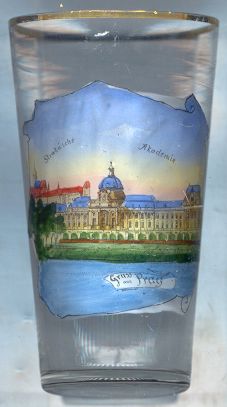

The so-called  Straka Academy (Strakova akademie) [left, no. 1813, and right, no. 4284]
today is the seat of the Czech Parliament. The neo-Baroque palace on the left bank of the Vltava river
was built in 1896 to finally fulfill the will of Baron Jan Petr Straka who in 1720 had left finances for a school for
young Czech nobles. It was under German occupation that Straka's Academy became the seat of government. Only in 1945 did
the Czech government definitively chose the former school as its offices.
Straka Academy (Strakova akademie) [left, no. 1813, and right, no. 4284]
today is the seat of the Czech Parliament. The neo-Baroque palace on the left bank of the Vltava river
was built in 1896 to finally fulfill the will of Baron Jan Petr Straka who in 1720 had left finances for a school for
young Czech nobles. It was under German occupation that Straka's Academy became the seat of government. Only in 1945 did
the Czech government definitively chose the former school as its offices.
Staré Město (Old Town)
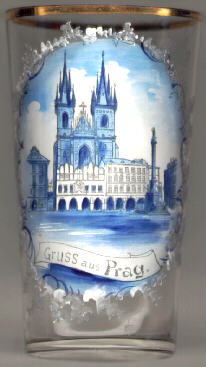
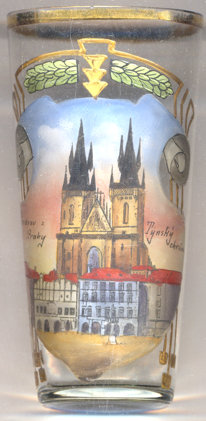
The  Church of Our Lady Before Tyn (Týnský chrám)
dominates one side of the Old Town Square (Staroměstské Náměstí) in Prague.
The church was founded in 1385 during the tumultuous periodwhen the 'heretic' Hussites were
opposed by the Roman Catholic Church. The Catholic Jesuits then made the church their own by recasting the bell and
replacing the Hussites symbolic chalice with a ten-foot figure of the Virgin Mary.
Church of Our Lady Before Tyn (Týnský chrám)
dominates one side of the Old Town Square (Staroměstské Náměstí) in Prague.
The church was founded in 1385 during the tumultuous periodwhen the 'heretic' Hussites were
opposed by the Roman Catholic Church. The Catholic Jesuits then made the church their own by recasting the bell and
replacing the Hussites symbolic chalice with a ten-foot figure of the Virgin Mary.
 Column of Our Lady [foreground right]
was pledged in 1648 as an expression of gratitude of the inhabitants of Prague for their success in defending the
city against the Swedish troops in the Thirty Years' War (1618–1648). The foundation was laid in 1650 and in the
same year the column was completed. However, the official unveiling in the presence of Emperor Ferdinand III
only took place in 1652. The column was demolished in 1918. In 1989 a society was founded which intends to rebuild
the historic column.
Column of Our Lady [foreground right]
was pledged in 1648 as an expression of gratitude of the inhabitants of Prague for their success in defending the
city against the Swedish troops in the Thirty Years' War (1618–1648). The foundation was laid in 1650 and in the
same year the column was completed. However, the official unveiling in the presence of Emperor Ferdinand III
only took place in 1652. The column was demolished in 1918. In 1989 a society was founded which intends to rebuild
the historic column.
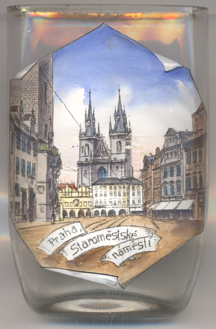
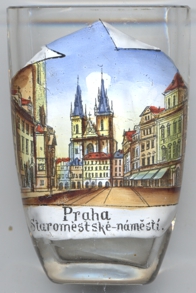
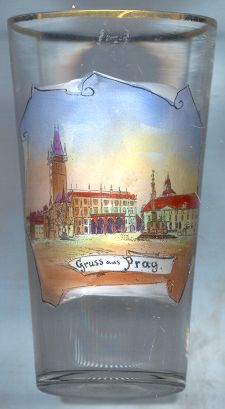
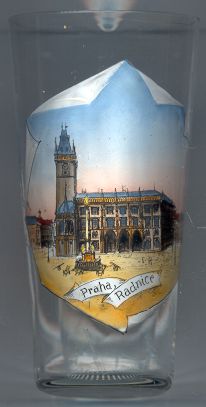
 Old Town Hall (Staroměstská radnice)
which is situated on the southwest corner of the square, is actually a fusion of buildings, each with a slightly different
architectural style. The earliest dates from the 14th century when King John of Luxembourg agreed to a modest dwelling
for the town clerk. As Prague developed into a wealthy trading city the Town Hall gradually expanded, incorporating Gothic
and Renaissance elements over later centuries. Probably the most interesting feature of the building is the astronomical
clock, which was incorporated into the structure in 1490.
Old Town Hall (Staroměstská radnice)
which is situated on the southwest corner of the square, is actually a fusion of buildings, each with a slightly different
architectural style. The earliest dates from the 14th century when King John of Luxembourg agreed to a modest dwelling
for the town clerk. As Prague developed into a wealthy trading city the Town Hall gradually expanded, incorporating Gothic
and Renaissance elements over later centuries. Probably the most interesting feature of the building is the astronomical
clock, which was incorporated into the structure in 1490.
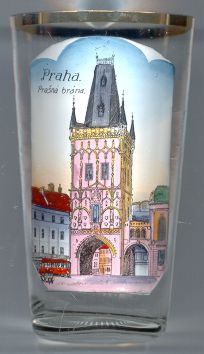
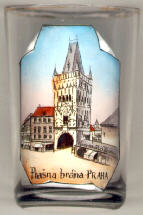
The  Powder Tower (Pražna brána, i.e. Prague Gate) [left, no. 1311, and right, no. 244]
was built in the late 15th century as a part of the new bulwarks designed by Benedikt Ried. The name "Mihulka" came in use
in the 19th century. Previously the structure had been successively called the New Tower, the Round Bastion, the Laboratory
or the Swedish Laboratory, and the Powder Tower. The Powder Tower was the largest of the cannon towers, but its defence
qualities were never put to the test. Up to the 20th century the dwelling quarters of the sacristans of St. Vitus
Cathedral were situated here.
Powder Tower (Pražna brána, i.e. Prague Gate) [left, no. 1311, and right, no. 244]
was built in the late 15th century as a part of the new bulwarks designed by Benedikt Ried. The name "Mihulka" came in use
in the 19th century. Previously the structure had been successively called the New Tower, the Round Bastion, the Laboratory
or the Swedish Laboratory, and the Powder Tower. The Powder Tower was the largest of the cannon towers, but its defence
qualities were never put to the test. Up to the 20th century the dwelling quarters of the sacristans of St. Vitus
Cathedral were situated here.
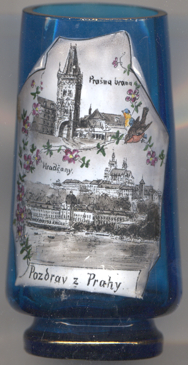
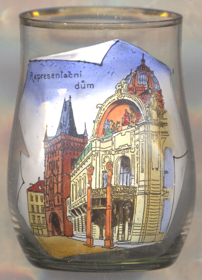

The  Municipal House (Obecní dům) [near left, no. 3104, and
right, no. 3731], right next to the Powder Tower,
was built in 1905–1912 on a site that had been occupied by the royal court palace where the kings of Bohemia
had lived between 1383 and 1485. The building was designed in Art Nouveau style by Osvald Polívka and
Antonín Balšánek. On 28 October 1918 this was the site where the Czechoslovak Republic was proclaimed.
The Municipal Hall also houses Smetana Hall, one of the celebrate concert venues of Prague.
Municipal House (Obecní dům) [near left, no. 3104, and
right, no. 3731], right next to the Powder Tower,
was built in 1905–1912 on a site that had been occupied by the royal court palace where the kings of Bohemia
had lived between 1383 and 1485. The building was designed in Art Nouveau style by Osvald Polívka and
Antonín Balšánek. On 28 October 1918 this was the site where the Czechoslovak Republic was proclaimed.
The Municipal Hall also houses Smetana Hall, one of the celebrate concert venues of Prague.
[https://en.wikipedia.org/wiki/Municipal_House, https://de.wikipedia.org/wiki/Obecní_dům]

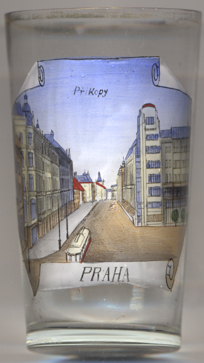
Glass no. 3730 is labeled Příkopy, i.e. 'moats'. The street, today is named
 Na příkopě
Na příkopě
[https://en.wikipedia.org/wiki/Na_příkopě]
 Palác Koruna ('Koruna palce'), also known as automat Koruna
('Koruna machine') [left, no. 3730: right] is a late Art Nouveau building located at the corner
of Na príkopě street and Wenceslas Square. It was built in 1911–1912 and was one of the first
constructions using reinforced concrete. The owner of the building was the First Czech Joint Stock Company for Life
Insurance, which later was renamed Koruna. The building was designed by architects Antonín Pfeiffer and
Matěj Blecha.
Palác Koruna ('Koruna palce'), also known as automat Koruna
('Koruna machine') [left, no. 3730: right] is a late Art Nouveau building located at the corner
of Na príkopě street and Wenceslas Square. It was built in 1911–1912 and was one of the first
constructions using reinforced concrete. The owner of the building was the First Czech Joint Stock Company for Life
Insurance, which later was renamed Koruna. The building was designed by architects Antonín Pfeiffer and
Matěj Blecha.
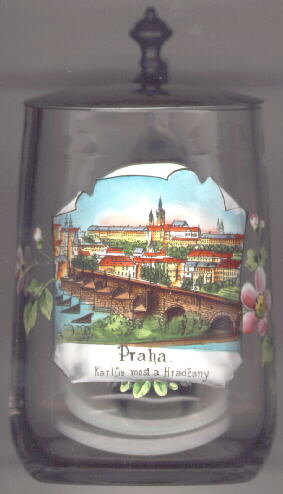
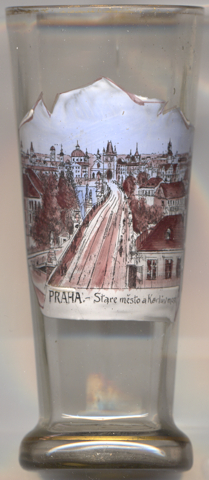
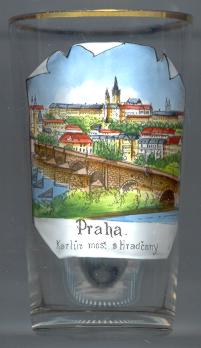
The  Charles Bridge (Karlův most)
connects the Old Town with the Lesser Side (Malá Strana). The construction of the bridge
began in 1354 under Charles IV and was finished at the beginning of the 15th century.
As the only means of crossing the river in Prague, the Charles Bridge used to be the most important connection
between the Old Town, Prague Castle and adjacent areas till 1841. The bridge was originally called the Stone Bridge
(Kamenný most) or the Prague Bridge (Pražský most) but has been the "Charles Bridge" since 1870.
The bridge is 516 meters long and nearly 10 m wide, resting on 16 arches shielded by ice guards,
and is decorated by a continuous alley of 30 statues and statuaries, erected around 1700.
Charles Bridge (Karlův most)
connects the Old Town with the Lesser Side (Malá Strana). The construction of the bridge
began in 1354 under Charles IV and was finished at the beginning of the 15th century.
As the only means of crossing the river in Prague, the Charles Bridge used to be the most important connection
between the Old Town, Prague Castle and adjacent areas till 1841. The bridge was originally called the Stone Bridge
(Kamenný most) or the Prague Bridge (Pražský most) but has been the "Charles Bridge" since 1870.
The bridge is 516 meters long and nearly 10 m wide, resting on 16 arches shielded by ice guards,
and is decorated by a continuous alley of 30 statues and statuaries, erected around 1700.
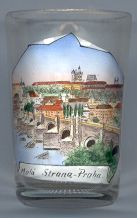
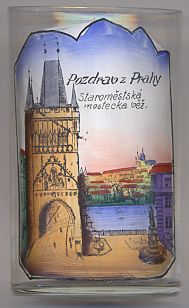
The bridge is protected by three bridge towers, two of them on the Lesser Side side and the third one on the Old Town side.
The  Old
Old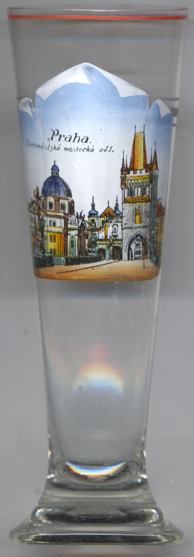
The  Church of St. Francis of Assisi (kostel svatého Františka z Assisi) or
St. Francis Seraphinus Church (kostel sv. Františka Serafínského) [near left, no. 4605: left]
is located on the right bank of the river Vltava, right next to the Old Town Bridge Tower. The church dates back to St. Agnes of Bohemia. In 1252 she
founded the Order of the Knights of the Cross with the Red Star, also known as the Military Order of the Crusaders of the Red Star, for which she had a hospital
with a Holy Spirit Church built at the bridge gate of what was then the Judith Bridge. Her brother, King Wenceslaus&I of Bohemia, entrusted the guarding and maintenance
of the bridge to the Knights in 1253 in return for the right to collect bridge and road tolls. These duties and privileges ceased in the 14th century with the
construction of the Charles Bridge. Today's church, standing on the foundation of the original Gothic church, was built in Baroque style between 1679 and 1688.
The design was provided by the architect Jean Baptiste Mathey, and the construction management was carried out by the master builder Domenico Canevale.
Church of St. Francis of Assisi (kostel svatého Františka z Assisi) or
St. Francis Seraphinus Church (kostel sv. Františka Serafínského) [near left, no. 4605: left]
is located on the right bank of the river Vltava, right next to the Old Town Bridge Tower. The church dates back to St. Agnes of Bohemia. In 1252 she
founded the Order of the Knights of the Cross with the Red Star, also known as the Military Order of the Crusaders of the Red Star, for which she had a hospital
with a Holy Spirit Church built at the bridge gate of what was then the Judith Bridge. Her brother, King Wenceslaus&I of Bohemia, entrusted the guarding and maintenance
of the bridge to the Knights in 1253 in return for the right to collect bridge and road tolls. These duties and privileges ceased in the 14th century with the
construction of the Charles Bridge. Today's church, standing on the foundation of the original Gothic church, was built in Baroque style between 1679 and 1688.
The design was provided by the architect Jean Baptiste Mathey, and the construction management was carried out by the master builder Domenico Canevale.
 Church of St. Salvator (kostel svatého Salvátora) [near left, no. 4605: background centre]
was built on the foundations of the Gothic Church of St. Clement, which was affiliated to the Dominican Order. The foundations of the building were laid
in 1578–1581 by the Jesuits. In 1581, the primate of the neighboring Jewish ghetto donated 100 thalers to build the church, which testifies to a completely
unprecedented tolerant atmosphere and the peaceful coexistence of different religions within Rudolfinian Prague. At the beginning of the 17th century, a nave and
a western marble portal with a portico were built. The church received built-in emporiums and stucco decoration. This construction was managed by the Italian architect
Carlo Lurago. At the end of the 1740s, a dome was constructed above the sanctuary. In 1654–1659, according to Lurago's design, a new representative façade
was built with three arched arcades reminiscent of Roman triumphal arches. The church towers were modified and raised in 1714.
Church of St. Salvator (kostel svatého Salvátora) [near left, no. 4605: background centre]
was built on the foundations of the Gothic Church of St. Clement, which was affiliated to the Dominican Order. The foundations of the building were laid
in 1578–1581 by the Jesuits. In 1581, the primate of the neighboring Jewish ghetto donated 100 thalers to build the church, which testifies to a completely
unprecedented tolerant atmosphere and the peaceful coexistence of different religions within Rudolfinian Prague. At the beginning of the 17th century, a nave and
a western marble portal with a portico were built. The church received built-in emporiums and stucco decoration. This construction was managed by the Italian architect
Carlo Lurago. At the end of the 1740s, a dome was constructed above the sanctuary. In 1654–1659, according to Lurago's design, a new representative façade
was built with three arched arcades reminiscent of Roman triumphal arches. The church towers were modified and raised in 1714.
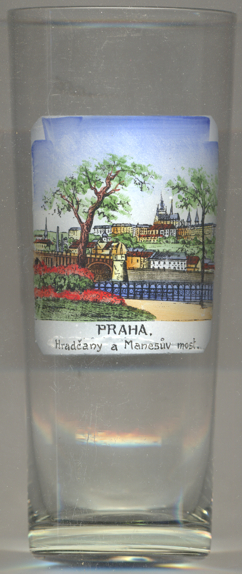
 Mánes Bridge (Mánesův most) [left, no. 3300: left]
spans the Vltava between the Aleš Embankment and the Rudolfinum (see below) on the Old Town (Staré Město)
side with the Lesser Town (Malá Strana). Replacing the previous Rudolf footbridge (built in 1869), the new bridge was
constructed in 1914–1916, built of concrete and supported on four segmental arches. Originally named Archduke Franz
Ferdinand Bridge, it was renamed Mánes Bridge in 1920, in honour of the Czech painter Josef Mánes.
Mánes Bridge (Mánesův most) [left, no. 3300: left]
spans the Vltava between the Aleš Embankment and the Rudolfinum (see below) on the Old Town (Staré Město)
side with the Lesser Town (Malá Strana). Replacing the previous Rudolf footbridge (built in 1869), the new bridge was
constructed in 1914–1916, built of concrete and supported on four segmental arches. Originally named Archduke Franz
Ferdinand Bridge, it was renamed Mánes Bridge in 1920, in honour of the Czech painter Josef Mánes.
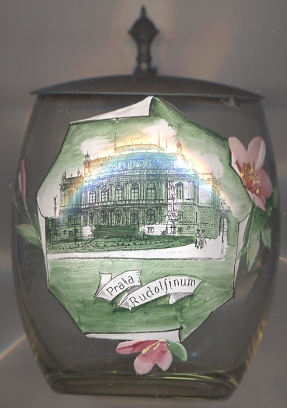
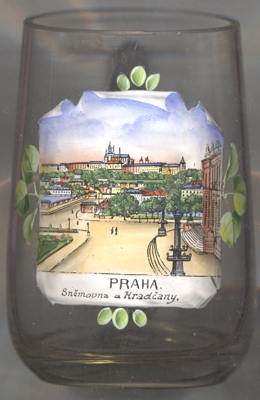
The  Rudolfinum [near left, no. 2839, and right, no. 4133: far right, abreöy visible]
was designed by architect Josef Zítek and his student Josef Schulz, and was opened 8 February 1885.
It is named in honour of Rudolf, Crown Prince of Austria, who presided over the opening. The Rudolfinum's Dvořák Hall is one of the oldest
concert halls in Europe and is noted for its excellent acoustics. On 4 January 1896 Antonín Dvořák himself conducted the Czech
Philharmonic in the hall in its first ever concert. After the founding of Czechoslovakia in 1918, the building was referred to as Dům
umělců ('House of Artists'). The building was modified several times, in the interwar period even for the needs of the Czechoslovak
National Assembly (glass no. 4133 [right] is thus labeled Sněmovna, i.e. 'House' or 'Chamber').
The Rudolfinum has been the home of the Czech Philharmonic Orchestra since 1946 and is one of the main venues of the Prague Spring International Music
Festival held each year in May and June. The building also contains the Galerie Rudolfinum, an art gallery that focuses mainly on contemporary art.
Rudolfinum [near left, no. 2839, and right, no. 4133: far right, abreöy visible]
was designed by architect Josef Zítek and his student Josef Schulz, and was opened 8 February 1885.
It is named in honour of Rudolf, Crown Prince of Austria, who presided over the opening. The Rudolfinum's Dvořák Hall is one of the oldest
concert halls in Europe and is noted for its excellent acoustics. On 4 January 1896 Antonín Dvořák himself conducted the Czech
Philharmonic in the hall in its first ever concert. After the founding of Czechoslovakia in 1918, the building was referred to as Dům
umělců ('House of Artists'). The building was modified several times, in the interwar period even for the needs of the Czechoslovak
National Assembly (glass no. 4133 [right] is thus labeled Sněmovna, i.e. 'House' or 'Chamber').
The Rudolfinum has been the home of the Czech Philharmonic Orchestra since 1946 and is one of the main venues of the Prague Spring International Music
Festival held each year in May and June. The building also contains the Galerie Rudolfinum, an art gallery that focuses mainly on contemporary art.
[http://en.wikipedia.org/wiki/Rudolfinum, https://cs.wikipedia.org/wiki/Rudolfinum]
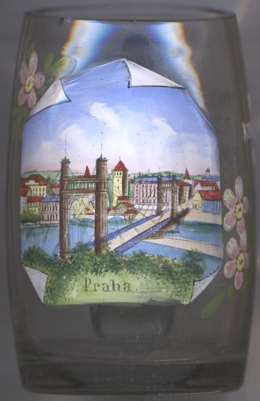
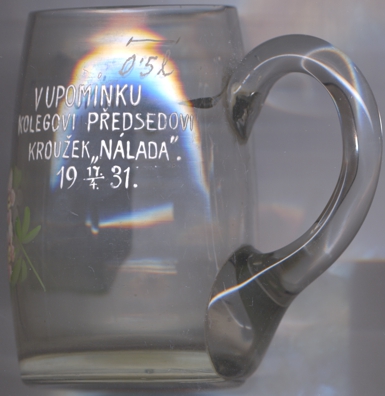
 Štefánikův most (Štefánik's Bridge) [near left, no. 4404]
connects Revoluční třída, which forms the border between the Old and New Towns on the right bank of the Vltava, with the
Letenský tunnel, Edvard Beneš embankment and Kapitán Jaroš embankment on the left bank (Holešovice). The original
bridge was built in 1865–1868 and was named most císaře Františka Josefa I for Emperor Franz Joseph I.
Reconstruction works were carried out in 1898. In 1919 it was renamed Štefánik's Bridge. Between 1940 and 1945 it was named
most Leoše Janáčka for composer Leoš Janácek. The old bridge was dismantled in 1946–1947 and a new
bridge was constructed in 1949–1951. This new bridge was named Švermův most for the journalist and politician Jan
Šverma. Since 1997 it again is named Štefánikův most for the Slovak politician, soldier, aviator, general of the
French army, astronomer and meteorologist Milan Rastislav Štefánik.
Štefánikův most (Štefánik's Bridge) [near left, no. 4404]
connects Revoluční třída, which forms the border between the Old and New Towns on the right bank of the Vltava, with the
Letenský tunnel, Edvard Beneš embankment and Kapitán Jaroš embankment on the left bank (Holešovice). The original
bridge was built in 1865–1868 and was named most císaře Františka Josefa I for Emperor Franz Joseph I.
Reconstruction works were carried out in 1898. In 1919 it was renamed Štefánik's Bridge. Between 1940 and 1945 it was named
most Leoše Janáčka for composer Leoš Janácek. The old bridge was dismantled in 1946–1947 and a new
bridge was constructed in 1949–1951. This new bridge was named Švermův most for the journalist and politician Jan
Šverma. Since 1997 it again is named Štefánikův most for the Slovak politician, soldier, aviator, general of the
French army, astronomer and meteorologist Milan Rastislav Štefánik.
[https://cs.wikipedia.org/wiki/%C5%A0tef%C3%A1nik%C5%AFv_most]
Nové Město (New Town)

 Wenceslas Square (Václavské náměstí)
is one of the main city squares and the centre of the business and cultural communities in the New Town of Prague.
Wenceslas Square has a shape of a very long (750 m, total area 45,000 m²) rectangle,
in a northwest–southeast direction. In 1348, Charles IV founded the New Town of Prague. The plan included several
open areas for markets, of which the second largest was the Koňský trh, or Horse Market, which we know today
as Wenceslas Square.
Wenceslas Square (Václavské náměstí)
is one of the main city squares and the centre of the business and cultural communities in the New Town of Prague.
Wenceslas Square has a shape of a very long (750 m, total area 45,000 m²) rectangle,
in a northwest–southeast direction. In 1348, Charles IV founded the New Town of Prague. The plan included several
open areas for markets, of which the second largest was the Koňský trh, or Horse Market, which we know today
as Wenceslas Square.
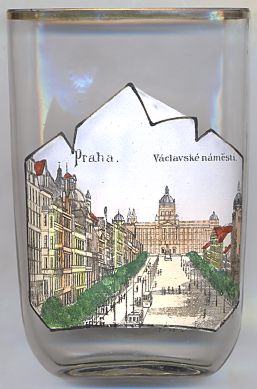
The  National Museum (Národní muzeum)
was founded 1818.
It was not until the end of the century that a truly distinguished and appropriate home for the museum collections was
constructed at the upper end of Wenceslas Square. Following the design of prominent Czech neo-Rennaisance architect
Josef Schulz, the new museum was built on the foundation of the Czech parliament from 1885–1891 at a cost of
approximately two million gold crowns. The beautiful palace became the dominant structure on Wenceslas Square and one of
the largest and prominent buildings in Prague.
At present the National Museum shelters almost 14 million of items from the area of natural history,
history, arts, music and librarianship, located in tens of buildings.
National Museum (Národní muzeum)
was founded 1818.
It was not until the end of the century that a truly distinguished and appropriate home for the museum collections was
constructed at the upper end of Wenceslas Square. Following the design of prominent Czech neo-Rennaisance architect
Josef Schulz, the new museum was built on the foundation of the Czech parliament from 1885–1891 at a cost of
approximately two million gold crowns. The beautiful palace became the dominant structure on Wenceslas Square and one of
the largest and prominent buildings in Prague.
At present the National Museum shelters almost 14 million of items from the area of natural history,
history, arts, music and librarianship, located in tens of buildings.
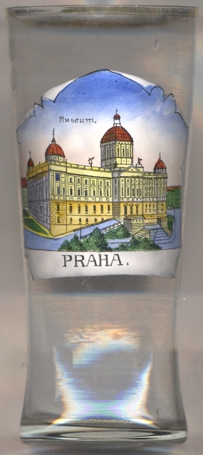
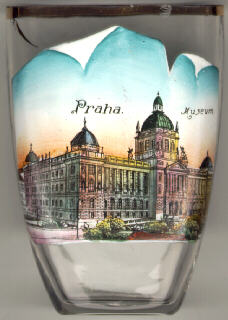
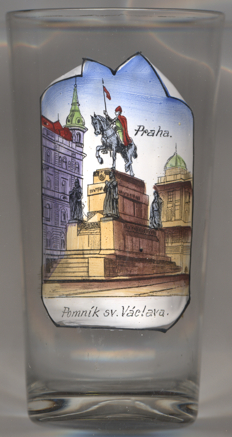
The street-like Wenceslas Square is dominated by the  monument
monument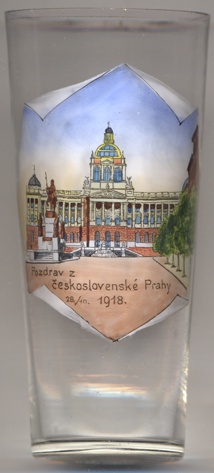
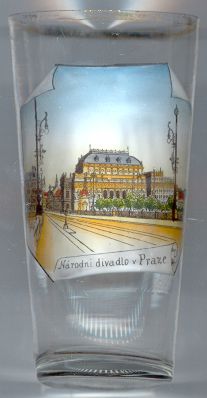

The  National Theatre (Národní divadlo)
belongs to the most important Czech cultural institutions with a rich artistic tradition.
Collections of money among the broad masses of the people facilitated its construction and so the ceremonious laying of
the foundation stone on May 16, 1868 was tantamount to an all-state political demonstration.
Architect Josef Zítek came out on top in an open competition and in 1867 construction work began.
In 1875 the new building reached the full height and in 1877 the theatre was roofed over.
The National Theatre was opened for the first time on June 11, 1881 to honour the visit of Crown Prince Rudolf of Austria.
Another eleven performances were presented after that. Then the theatre was closed down to enable the completion of the
finishing touches. While this work was under way a fire broke out on August 12, 1881 which destroyed the copper dome,
the auditorium and stage of the theatre. The fire was seen as a national catastrophe and met with a mighty wave of
determination to set up a new collection: within 47 days a million guldens were collected.
The building of the National Theatre was then inaugurated on November 18, 1883 with a performance of Smetana's festive
opera Libuše composed for this occasion.
National Theatre (Národní divadlo)
belongs to the most important Czech cultural institutions with a rich artistic tradition.
Collections of money among the broad masses of the people facilitated its construction and so the ceremonious laying of
the foundation stone on May 16, 1868 was tantamount to an all-state political demonstration.
Architect Josef Zítek came out on top in an open competition and in 1867 construction work began.
In 1875 the new building reached the full height and in 1877 the theatre was roofed over.
The National Theatre was opened for the first time on June 11, 1881 to honour the visit of Crown Prince Rudolf of Austria.
Another eleven performances were presented after that. Then the theatre was closed down to enable the completion of the
finishing touches. While this work was under way a fire broke out on August 12, 1881 which destroyed the copper dome,
the auditorium and stage of the theatre. The fire was seen as a national catastrophe and met with a mighty wave of
determination to set up a new collection: within 47 days a million guldens were collected.
The building of the National Theatre was then inaugurated on November 18, 1883 with a performance of Smetana's festive
opera Libuše composed for this occasion.
Vinohrady

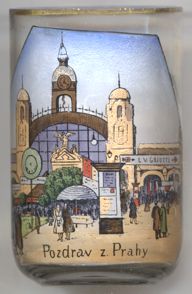
 Praha hlavní nádraží (Prague Main Station) [left, no. 4717, and
right, no. 4717] is the largest railway station in Prague. It opened in 1871 as Kaiser-Franz-Joseph-Bahnhof, named for
Emperor Franz Joseph I of Austria. During the First Republic and from 1945 to 1948 the station was called Wilsonovo nádraží
(Wilson Station), after the former President of the United States Woodrow Wilson, who had campaigned for an independent Czechoslovakia in 1918.
The station is the largest Art Nouveau monument in the Czech Republic, built in 1901–1909 by the architect Josef Fanta on the site of the
old dismantled Neo-Renaissance station that had been designed by architects Antonín Viktor Barvitius and Vojtěch Ignác
Ullmann. Since 31 December 1976, it has been a cultural monument of the Czech Republic and since 1993 it has been part of the urban
monument zone of Vinohrady, Žižkov and Vršovice.
Praha hlavní nádraží (Prague Main Station) [left, no. 4717, and
right, no. 4717] is the largest railway station in Prague. It opened in 1871 as Kaiser-Franz-Joseph-Bahnhof, named for
Emperor Franz Joseph I of Austria. During the First Republic and from 1945 to 1948 the station was called Wilsonovo nádraží
(Wilson Station), after the former President of the United States Woodrow Wilson, who had campaigned for an independent Czechoslovakia in 1918.
The station is the largest Art Nouveau monument in the Czech Republic, built in 1901–1909 by the architect Josef Fanta on the site of the
old dismantled Neo-Renaissance station that had been designed by architects Antonín Viktor Barvitius and Vojtěch Ignác
Ullmann. Since 31 December 1976, it has been a cultural monument of the Czech Republic and since 1993 it has been part of the urban
monument zone of Vinohrady, Žižkov and Vršovice.
Vyšehrad
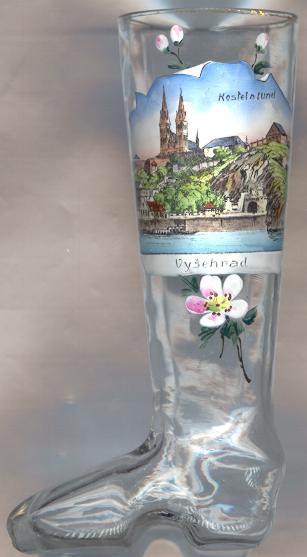
The  basilica of St. Peter and Paul (kostel svatého Petra a Pavla) was originally built in Romanesque style in 1079.
After a large fire the church was rebuilt in 1249 in Gothic style. Further changes followed in the 14th century. However, in 1420 the church was
destroyed during the HUssites wars. After that it was restored and rebuilt in Baroque style in the 1720s. The present neo-Gothic appearance of the church was
largely formed by a remodeling from 1920 onwards. The church obtained the Papal status of a Basilica minor in 2003.
basilica of St. Peter and Paul (kostel svatého Petra a Pavla) was originally built in Romanesque style in 1079.
After a large fire the church was rebuilt in 1249 in Gothic style. Further changes followed in the 14th century. However, in 1420 the church was
destroyed during the HUssites wars. After that it was restored and rebuilt in Baroque style in the 1720s. The present neo-Gothic appearance of the church was
largely formed by a remodeling from 1920 onwards. The church obtained the Papal status of a Basilica minor in 2003.
Žižkov
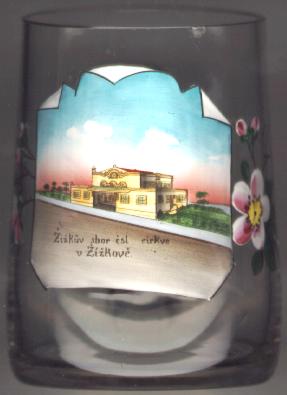

The  church of the Czechoslovak Hussite Church community
was founded in 1920 by former Czech catholic priest Karel Farský.
The Czechoslovak Hussite Church (Církev československá husitská CCH) is a Christian Church which separated from
Roman Catholic Church after World War I in former Czechoslovakia. It traces its tradition back to the Hussite reformers
and acknowledges Jan Hus (see Husinec) as its predecessor. Membership is estimated at between
100,000 and 180,000 adherents, mostly in the Czech Republic and some in Slovakia. There are 307 congregations divided
into five dioceses situated in Prague, Plzeň, Hradec Králové,
Brno, and Olomouc.
church of the Czechoslovak Hussite Church community
was founded in 1920 by former Czech catholic priest Karel Farský.
The Czechoslovak Hussite Church (Církev československá husitská CCH) is a Christian Church which separated from
Roman Catholic Church after World War I in former Czechoslovakia. It traces its tradition back to the Hussite reformers
and acknowledges Jan Hus (see Husinec) as its predecessor. Membership is estimated at between
100,000 and 180,000 adherents, mostly in the Czech Republic and some in Slovakia. There are 307 congregations divided
into five dioceses situated in Prague, Plzeň, Hradec Králové,
Brno, and Olomouc.
Bubeneč

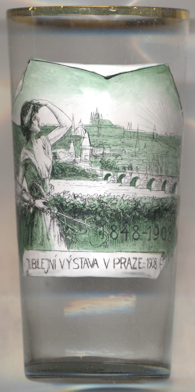
The  Jubilee Exhibition of the Commerce and Trade Chamber took place in 1891 in the fair grounds of
Bubeneč near Prague (since 1922 part of Prague), marking the 100th anniversary of the first Prague industry exhibition of
1791, which had been the first on the European continent. Another Jubilee exhibition took place here in 1908, marking the
60th anniversary of Emperor Franz Joseph I as a monarch. After the end of the exhibition most of the buildings
were dismantled.
Jubilee Exhibition of the Commerce and Trade Chamber took place in 1891 in the fair grounds of
Bubeneč near Prague (since 1922 part of Prague), marking the 100th anniversary of the first Prague industry exhibition of
1791, which had been the first on the European continent. Another Jubilee exhibition took place here in 1908, marking the
60th anniversary of Emperor Franz Joseph I as a monarch. After the end of the exhibition most of the buildings
were dismantled.
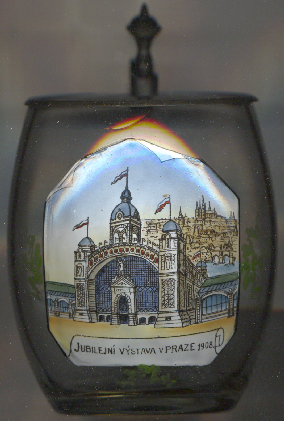
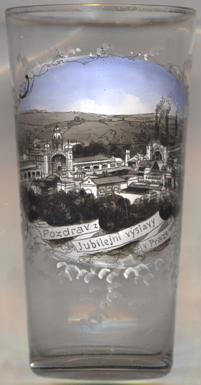
The  Palace of Industry (Průmyslový palác) [near left,
no. 3968, and right, no. 3857: background left] was created in Baroque revival style with elements
of early Art Nouveau style by the architect Bedřich Münzberger. Its most prominent features were a steal arch
construction with a length of 238 metres and a tower with a height of 51 metres. The building still stands today,
just the entire left wing was destroyed by a fire in October 2008.
Palace of Industry (Průmyslový palác) [near left,
no. 3968, and right, no. 3857: background left] was created in Baroque revival style with elements
of early Art Nouveau style by the architect Bedřich Münzberger. Its most prominent features were a steal arch
construction with a length of 238 metres and a tower with a height of 51 metres. The building still stands today,
just the entire left wing was destroyed by a fire in October 2008.
 machine
machine
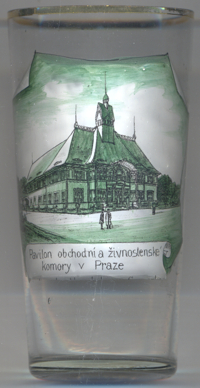
Glass no. 3154 [near left] shows a view of the
 Pavilion
PavilionHolešovice
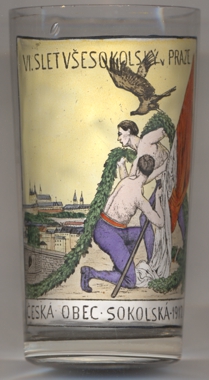
Glass no. 4055 [left] is a souvenir from the  6th meeting
6th meeting
The labeling on the glass reads
VI. VŠESOKOLSKÝ SLET v PRAŽE / ČESKÁ OBEC SOKOLSKÁ 1912
(6th All-Sokol Meeting in Prague / Czech Sokol Village 1912).
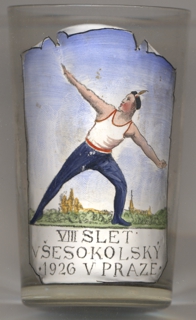
Glass no. 4102 [near left] is a souvenir from the  8th meeting
8th meeting
The labeling on the glass reads
VIII. SLET VŠESOKOLSKÝ 1926 V PRAŽE
(8th All-Sokol Meeting 1926 in Prague).
![[scale]](lineal.jpg)